
Dromore Castle is a manor house in Templenoe, County Kerry, Ireland, looking out over the Kenmare River. It was built in the 1830s for the Mahony family to a neo-Gothic design by Sir Thomas Deane. [1]

Dromore Castle is a manor house in Templenoe, County Kerry, Ireland, looking out over the Kenmare River. It was built in the 1830s for the Mahony family to a neo-Gothic design by Sir Thomas Deane. [1]
Dromore Castle was designed and built for Denis Mahony by the architect Thomas Deane, probably assisted by his brother Kearns Deane. Work began in 1831, although the account books show that only a negligible amount had been carried out before May 1834. Building work was completed in 1839. [2]
The house is in the castellated Gothic Revival style, with an external finish of Roman Cement with limestone dressings. With the notable exception of the grand south facing window with its pointed arch, the windows consist of pointed tracery contained within rectangular frames, a style characteristic of Deane's domestic work. The entrance hall, which is in the form of a long gallery, takes up half of the area of the ground floor. The west wing of the Castle takes the form of a round tower, with a spiral staircase contained within an attached turret.
Although Dromore Castle appears to have been built on the instructions of Denis Mahony, his father John Mahony had made the decision to build a large home earlier in the 19th century, but apparently abandoned the attempt after his yacht, returning from London with lead for the roof and wine for the cellar, sank in the Kenmare River, in view of the site of the house. After this, no further work took place until Deane began building work for Denis Mahony in the 1830s
Denis Mahony was a minister of the Church of Ireland and a keen proselytiser. He is known to have set up a soup kitchen at Dromore during the time of the Great Famine, and preached in the chapel at Dromore to the hungry who came for food. His proselytizing activities did not make him a popular figure in the locality, and in 1850 he was attacked in his church at Templenoe. On returning to Dromore, he found a further angry group had uprooted flower beds, felled trees and were about to set fire to the castle; it is claimed that they were only stopped by the intervention of the local Catholic priest, Fr John O'Sullivan.
After Rev. Denis Mahony's death in 1851, the castle was inherited by his son Richard John Mahony, who successfully ran the estate in addition to farming oyster beds in the bay. When Richard Mahony died, the castle then passed in turn to his son, Harold Segerson Mahony.
Harold Mahony was a successful tennis player, and indeed was the last Irish winner at Wimbledon. His tennis court can still be found in the gardens at the Castle. It was in the late 1800s, during Harold Mahony's time as head of the household, that Harold Boulton, best known for writing the lyrics of the Skye Boat Song, came to visit Dromore, and it is then that he is thought to have written the words to the popular song "The Castle of Dromore," published in 1892 in English and later translated into Irish. [3]
When Harold Mahony was killed in a bicycle accident in 1905, he left no heirs, and the castle was passed to his sister, Norah Hood. She in turn left the castle to her cousin, Hugh Bolton Waller, and the castle remained in the hands of the Waller family until 1993 when it was offered for sale. Dromore Castle is now owned by an investment company who are attempting to restore the house.
Beyond the castle's gardens and outbuildings, the majority of the former grounds are now owned by Coillte Teoranta, the Irish forestry board. The Kerry Way runs through the grounds, and there are various footpaths leading to the Kenmare River. Entrance to the grounds from the N70 road between Kenmare and Sneem is through a castellated gatehouse, also by Thomas Deane.

Lismore Castle is a castle located in the town of Lismore, County Waterford in the Republic of Ireland. It belonged to the Earls of Desmond, and subsequently to the Cavendish family from 1753. It is currently the Irish home of the Duke of Devonshire. It was largely re-built in the Gothic style during the mid-nineteenth century for the 6th Duke of Devonshire.
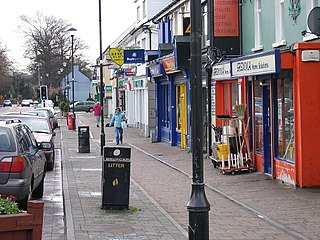
Shankill is an outlying suburb of Dublin, Ireland, on the southeast of County Dublin, close to the border with County Wicklow. It is in the local government area of Dún Laoghaire–Rathdown and had a population of 14,257 as of the 2016 census. It runs from the coast, between Loughlinstown and Bray, inland towards the foothills of the Dublin Mountains. Shankill borders Rathmichael, as well as Loughlinstown, Killiney, Ballybrack and Bray in County Wicklow. It is part of the civil parish of Rathmichael and contains the formerly separate district of Shanganagh, and in its southern parts, the locality of Crinken.

Kenmare is a small town in the south of County Kerry, Ireland. The name Kenmare is the anglicised form of Ceann Mara, meaning "head of the sea", referring to the head of Kenmare Bay. It is also a townland and civil parish.
Events in the year 1905 in Ireland.
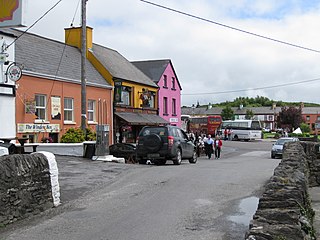
Sneem is a village situated on the Iveragh Peninsula, in County Kerry, in the southwest of Ireland. It lies on the estuary of the River Sneem which expands here to Kenmare Bay. The N70 road runs through the town, which is approximately 22 kilometres (14 mi) west of Kenmare. While the 2022 census recorded a population of 386 people, Sneem is located in a tourist area and the population increases during the summer months.

Romanesque Revival is a style of building employed beginning in the mid-19th century inspired by the 11th- and 12th-century Romanesque architecture. Unlike the historic Romanesque style, Romanesque Revival buildings tended to feature more simplified arches and windows than their historic counterparts.

Kilgarvan is a small village in County Kerry, Ireland. It is situated on the banks of the Roughty River which flows into Kenmare Bay. The nearest town is Kenmare which is 11 km to the west along the R569 road. Killarney is 18 km to the north. Kilgarvan is part of the civil parish of the same name.

Harold Segerson Mahony was a Scottish-born Irish tennis player who is best known for winning the singles title at the Wimbledon Championships in 1896. His career lasted from 1888 until his death in 1905. Mahony was born in Scotland but lived in Ireland for the majority of his life; his family were Irish including both of his parents, the family home was in County Kerry, Southwestern Ireland. He was the last Scottish born man to win Wimbledon until the victory of Andy Murray at the 2013 championships. He remains the most recent Irish singles champion at the All England Club.

Templenoe is a civil parish in County Kerry, Ireland. It is situated four miles from Kenmare, on the N70 road to Sneem, which forms part of the Ring of Kerry.

Francis Johnston was an Anglo/Irish architect, best known for building the General Post Office (GPO) on O'Connell Street, Dublin.

Dunkerron Castle is a ruined four-storey tower house located in Templenoe, near Kenmare, County Kerry, in south-west Ireland. The castle was the family seat of the O'Sullivan Mór family from the late 16th century.
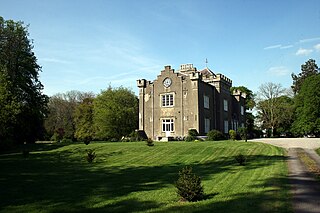
Paulstown is a small village in County Kilkenny in Ireland.

Blackrock is a suburb, with a village core, in the southeast of Cork City, Ireland. Originally a small fishing village about five kilometres from Cork City, the growth of the city over time has meant that the village has become incorporated into the city. It is home to Blackrock GAA club, Blackrock Castle, a weekly farmers market, and as of 2015 has seen some investment in regeneration projects for the traditional village centre. Blackrock is within the Cork South-Central Dáil constituency.

Shankill Castle and Gardens is set in parkland near Paulstown on the Carlow/Kilkenny border. Visitors are invited to walk in the grounds and gardens, and there are guided tours of the house.
The High Sheriff of Kerry was the British Crown's judicial representative in County Kerry, Ireland from the 16th century until 1922, when the office was abolished in the new Free State and replaced by the office of Kerry County Sheriff. The sheriff had judicial, electoral, ceremonial and administrative functions and executed High Court Writs. In 1908, an Order in Council made the Lord-Lieutenant the Sovereign's prime representative in a county and reduced the High Sheriff's precedence. However, the sheriff retained his responsibilities for the preservation of law and order in the county. The usual procedure for appointing the sheriff from 1660 onwards was that three persons were nominated at the beginning of each year from the county and the Lord Lieutenant then appointed his choice as High Sheriff for the remainder of the year. Often the other nominees were appointed as under-sheriffs. Sometimes a sheriff did not fulfil his entire term through death or other event and another sheriff was then appointed for the remainder of the year. The dates given hereunder are the dates of appointment. All addresses are in County Kerry unless stated otherwise.

Dundanion Castle is a Tudor tower house in the Blackrock area of Cork in Ireland. Previously known as Galwey's Castle, the ruin is located on the grounds of the much later "Dundanion House".
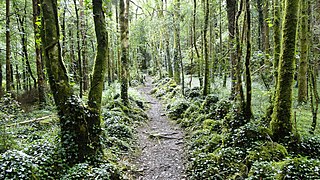
Dromore, County Clare is a rural townland in County Clare in the Republic of Ireland. It is located in the parish of Ruan and was formerly the location of Dromore House. Today, most of the townland is accounted for by Dromore Wood Nature Reserve. It is open to the public and also contains the ruins of Dromore Castle.
Colthurst's Bridge is situated 2.9 km (1.8 mi) north of Coachford village in County Cork, Ireland, 3.7 km (2.3 mi) east of Aghabullogue village, and is depicted on both the 1841 and 1901 surveyed OS maps. The bridge is located at the meeting point of the townlands of Carrignamuck, Clonmoyle East and Peake, the civil parishes of Aghabullogue and Magourney, and lies within the Catholic parish of Aghabullogue.
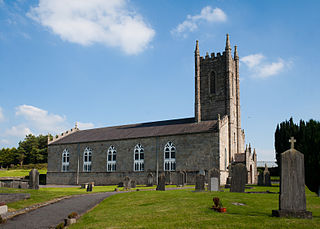
St. Cronan's Church is a 19th-century Church of Ireland church in Roscrea, County Tipperary, Ireland. The church was constructed in 1812 on the site of the original 12th century Romanesque church. The grounds include a graveyard and a replica high cross, enclosed by a rubble stone wall, cast iron gate and railings.
Busherstown House is a country house in Busherstown, on the Offaly/Tipperary border, Republic of Ireland. It was built by Humphrey Minchin in 1740 and rebuilt in c.1810 following a fire. It was then that the house was given its fine gothic revival frontage, including terminating towers and a parapet to the West front. The house was owned by the Minchin family up until it was sold for the first time in 1973.